Gear Review: IK Multimedia iLoud Micro Monitors
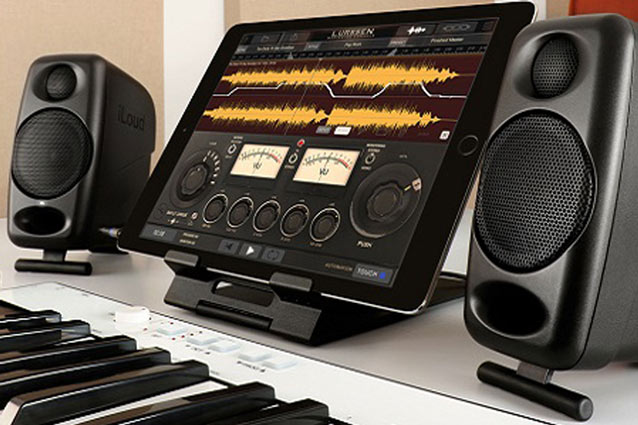
This is a syndicated version of Guitar Chalk’s iLoud Micro Monitors review.
For their small size, the iLoud Micro Monitors are a loud, powerful, well-designed and functional speaker set.
The design, which is optimized for smaller rooms and recording studios, combined with precise technological innovation, results in almost zero distortion, lowered impedance and a more constant output.
I had a chance to unbox a set and try them out for myself in my living room.
During my iLoud Micro Monitors review session, I used the pair for the following tasks:
- 1. Streaming music
- 2. Playing guitar
- 3. Monitoring basic recording
IK Multimedia designed the iLoud Micro Monitors to be particularly ideal for small studio spaces and to provide an optimal monitoring experience that avoids the unnatural frequency response and standing waves that can come from putting a large monitor in a small space.
From a technical perspective, the design process is involved and worth at least a brief overview.
Get The Pick Newsletter
All the latest guitar news, interviews, lessons, reviews, deals and more, direct to your inbox!
We'll start with the basics of audio engineering in a small room.
Technology Behind iLoud Micro Monitors
In simpler language, here are a few of the advantages IK has focused on by building a smaller monitor:
1. Allows you to sit closer to the sound source at lower sound pressure levels (SPL)
2. Reduced sound reflection off of walls and ceilings
3. Can be placed closer to one another (helpful for laptops and computers).
For room size, IK gives an example of a 13-by-10 foot room, with both monitors placed on a desk.
Example room size given for the iLoud Micro Monitors. | Image via IK Multimedia
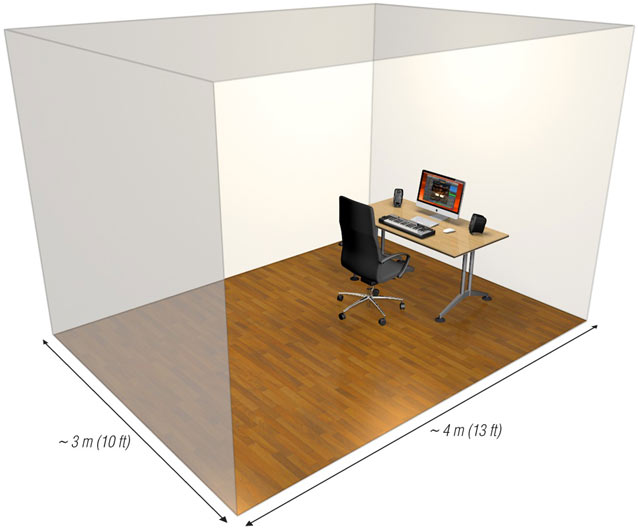
The following graphic shows the monitors set up to form a stereo equilateral triangle at a computer desk.
Triangular signal at a computer desk with each monitor in close proximity. | Image via IK Multimedia
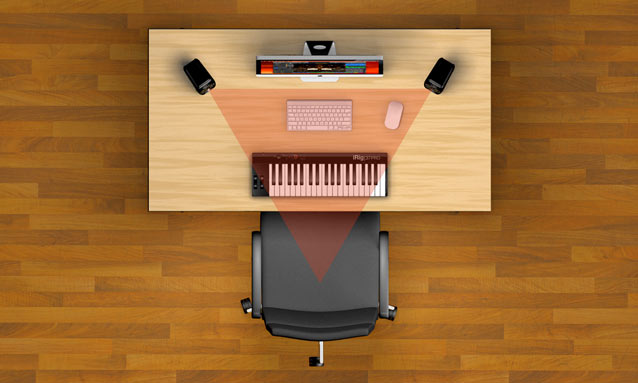
My Setup for the iLoud Micro Monitors Review
My setup was fairly similar. Since I don't have a desk in our living room (and my studio/office is being renovated), I went ahead and set up the monitors on the ottoman in front of a chair in the living room on either side of my laptop.
I had the pair of iLoud Micro Monitors setup on either side of my laptop.
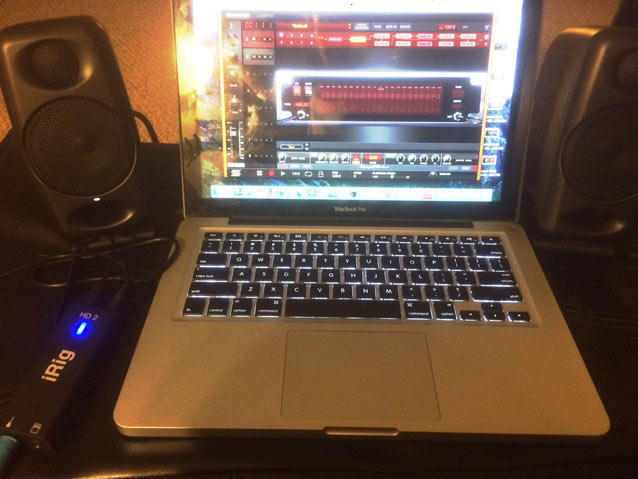
I should also mention that there was a wall directly behind where I was sitting, and a large window on the other side of the room. This means that, while my setup wasn't textbook, it was a small space that gave me an opportunity to test the iLoud Micro Monitor's capability.
Before we talk about the results, I want to point out a few more technical features that IK highlights.
Other Technical Features of the iLoud Micro Monitors
There are primarily five "highlight reel" features that IK points out on the product page, four of which I'll briefly cover so you can see why these monitors sound as good as I'm about to claim they do. The four features I'll highlight include the following:
1. Position EQ switches
2. Woofer and tweeter spacing (closer together)
3. Crossover and driver alignment
4. Proper power amps
#1: Position EQ Switches
Large monitors will often produce a "booming" sound when used in a small space. To correct this, IK has placed a FLAT/DESK switch that helps to calibrate each speaker depending on how close to a wall it might be.
This reduces the space they have to be moved out onto your desk, and corrects the undefined muddiness you can get from larger monitors that are too close to a wall.
The EQ switch on the back of the iLoud Micro Monitor. | View Larger Image
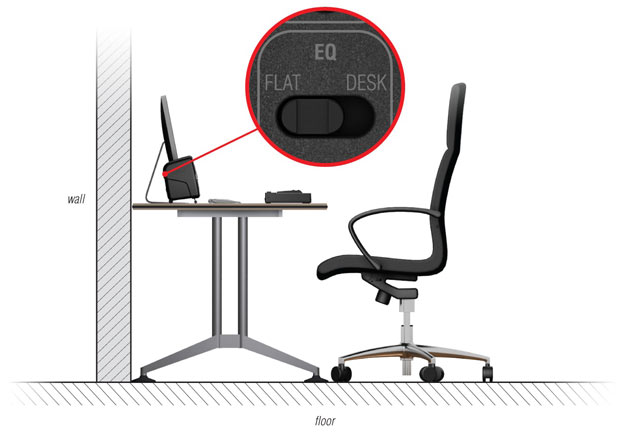
#2: Less distance between the woofer and tweeter
Having the tweeter and woofer in each speaker closer together helps to put the convergence point (also called the crossover point) or "sweet spot" of the two audio sources much closer to wherever they're sitting.
With only three inches between the two speakers (six is more typical) the convergence point is much closer to the actual speakers. | View Larger Image
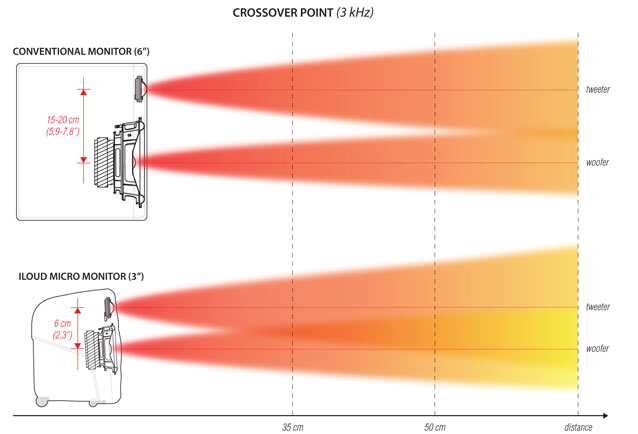
#3: Crossover and driver alignment
Audio drivers are paired in loudspeakers so they can cover low and high frequencies, at varying volumes, without distortion. Audio crossovers split the signal pre-driver into different frequency bands, prior to being amplified. This can also be called an "active crossover."
The iLoud monitors employ an active crossover method where the two drivers are crossed via a digital signal processor (DSP), which results in the response coming to your ear as a singular sound. In other words, it doesn't sound like it's coming from two separate speakers between the tweeter and woofer.
This phenomenon can be visualized via the following diagram:
A diagram of the crossover alignment in the iLoud Micro Monitor and a conventional monitor. | View Larger Image

#4: Proper Power Amps
The bi-amp design of the monitors means that the amplifiers are always operating around 50-60% of the total amount of power they're capable of delivering. The end result is that you have a pair of monitors that are great at avoiding unwanted distortion.
I can attest, clipping and excess noise were both a non-issue with this pair.
A graph showing the iLoud Micro Monitor's bi-amp system closely following the original signal. | View Larger Image
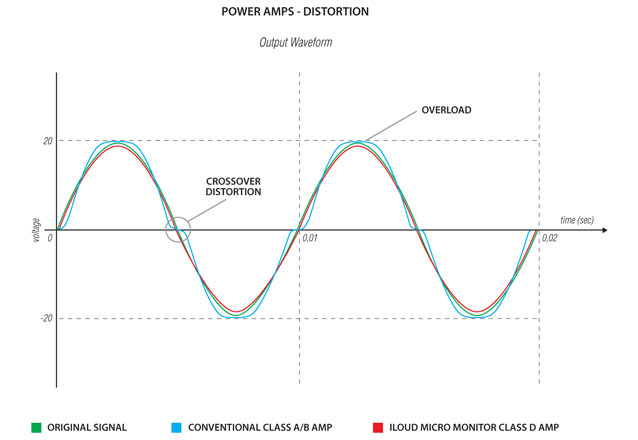
Moreover, the sound was just crisp and defined, which is due to the crossover alignment (mentioned earlier) and the bi-amp design that seems to work in tandem.
Basic iLoud Micro Monitors Features
Aside from the benefits made evident by its size, the iLoud Micro Monitors boast a number of premium features, and don't simply rely on their mobility to be unique and useful. Here are few that are particularly helpful.
• Bluetooth compatible
• RCA inputs
• 1/8" stereo input
• Right speaker power switch
• Bi-amp produces 50W RMS.
The only thing I really missed was a 1/4" TRS input, though with a USB interface, namely the iRig HD 2, I was still able to play guitar through the monitors quite easily.
Using my iRig HD 2 to plug my guitar (the blue cable) into the iLoud Micro Monitors. | View Larger Image
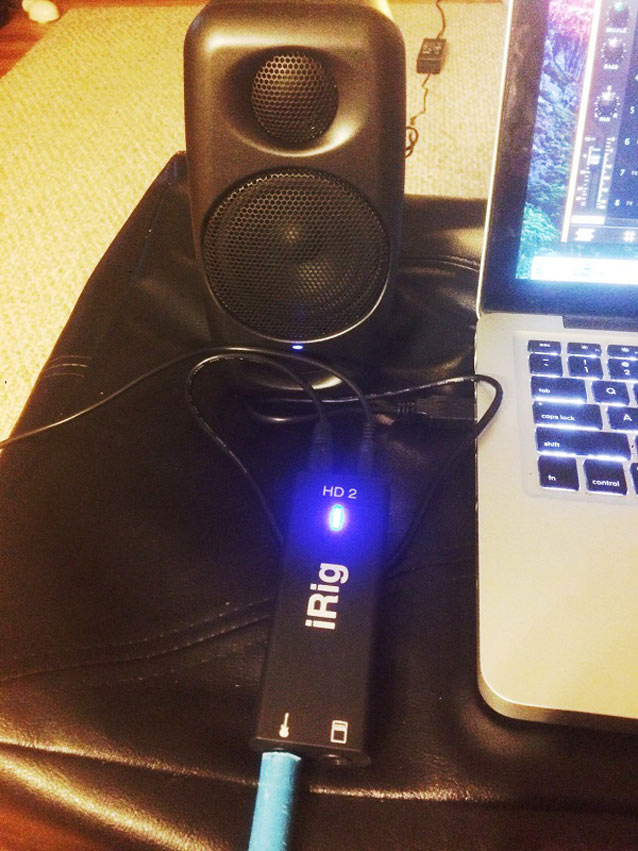
The absence of a 1/4" TRS input is likely due to the availability of the iRig interfaces and the smaller size of the iLoud monitors. Otherwise, there was nothing I missed in terms of monitor features.
Sound Quality of the iLoud Micro Monitors
Looking at the iLoud Micro Monitors, it's hard to assume they could make a lot of noise or sound "big." But, after using the pair, their volume and intensity was the most surprising and pleasing feature. They just sound so much bigger than they look, and what's more, it didn't seem to matter what I plugged into them.
Nothing ever sounded small or like a tin can.
The Guitar Setup
Playing guitar through the unit was a big test, since guitar amps typically pack much bigger speaker systems. However, the iLoud Micro Monitors passed with flying colors as they captured the tone of my PRS CE 24 perfectly. Here's how I had my guitar setup:
1. Guitar plugs into the iRig HD 2 interface
2. Signal runs through GarageBand (I also tried it with Amplitube 4)
3. Processed signal goes into the monitors via the provided RCA cable
I tried a clean and distorted tone via amp models in both pieces of software.
Settings and effects responded like you would expect from a full guitar rig, while output from the speakers sounded heavy and thick, like I was playing through an actual guitar amp or a much larger pair of speakers.
Final Verdict
The iLoud Micro Monitors are a steep investment at just under $300, though this is still cheaper than many larger budget to mid-grade monitors. Furthermore, the iLoud set is on par (or better, depending on room size) in terms of sound quality.
We guitar players would like to see a 1/4" input for more convenient instrument use, but that can be easily achieved with an inexpensive adapter (1/4" to 1/8" TRS; I'd recommend this one by FosPower or an interface like the iRig HD 2.
But overall, the sound quality of the pair is just astounding, especially when you consider their small size.
A blindfold test would fool anyone into thinking they're listening to a mid-sized guitar amp or larger pair of studio monitors.
Bobby Kittleberger is the managing editor at Guitar Chalk and author of the book Music Theory for Guitar Players in Plain English. You can get in touch with him here or via Twitter.
Bobby is the founder of Guitar Chalk, and responsible for developing most of its content. He has worked with leading guitar industry companies including Sweetwater, Ultimate Guitar, Seymour Duncan, PRS, and many others.
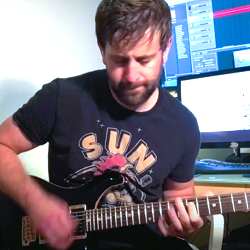


![[from left] George Harrison with his Gretsch Country Gentleman, Norman Harris of Norman's Rare Guitars holds a gold-top Les Paul, John Fogerty with his legendary 1969 Rickenbacker](https://cdn.mos.cms.futurecdn.net/TuH3nuhn9etqjdn5sy4ntW.jpg)







